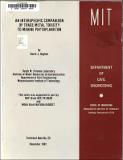| dc.description.abstract | Introduction: Over the past few years, the emphasis placed on quantifying the metal speciation in culture media has clarified considerably our understanding of trace metal effects on phytoplankton. For example, it is now generally accepted that copper toxicity is controlled by the activity of the cupric ion (Davey et al., 1974; Sunda, 1975; Sunda and Guillard, 1976; Anderson and Morel, 1978; Morel, N.M.L. et al., 1978). It has also been demonstrated that the availability of metals for nutrition is dependent on their free ion activities (Manahan and Smith, 1973; Anderson et al., 1978; Anderson and Morel, in prep.). While there is no practical analytical method for determining free metal activities in seawater, the availability of convenient computer programs and a suitable range of synthetic chelators make it possible to calculate metal activities for controlled laboratory experiments performed in chemically defined (and buffered) culture media and to relate these results to field conditions, where metals and ligands are generally present at lower concentrations (Sunda and Guillard, 1976; Morel et al., 1979). The limited available data on metal toxicity in phytoplankton cultures demonstrate wide differences in metal sensitivities among species (e.g., compare Anderson and Morel, 1978; and Morel et al., 1978), leading to the hypothesis that trace metals may partially control the composition of species assemblages in natural waters. This hypothesis is supported by the results of in situ experiments. For example, addition of copper in the plastic enclosures of the CEPEX experiments resulted in a shift of dominant algal species from centric diatom and dinoflagellates to pennate diatoms and microflagellates (Goering et al., 1977). In lakes and reservoirs such a shift in algal species is commonly observed upon copper sulfate treatment for control of nuisance algae (McKnight, 1981). In order to begin documenting the possible role of trace metals as natural modulators of phytoplankton species assemblages in marine systems, we need to know a great deal more about what metals, in addition to copper and zinc, may be toxic or limiting in the range of metal activities that prevail in the ocean; we need also to undersand what differences in metal sensitivities there might be among the principal algal species. The toxic effects of metals may be observed in several ways, some of which are not consistent with each other. There are numerous reports of depressed photosynthesis and growth rates under metal stress. Morel et al. (1978) reported a systematic increase in the lag phase of Skeletonema costatum as a function of cupric ion activity. However, the subsequent division rate of the organism during exponential growth was not affected by the copper. Stewart (1977) measured the biomass of batch cultures after eight days incubation in lead-treated media, which would fail to discriminate between a prolonged lag phase and a depressed growth rate. Even a careful study of growth rate sometimes yields ambiguous results. Sunda (1975) reported a delay of up to three days in development of acute copper toxicity. Several of his cultures displayed declining growth rates with time. Other methods of assessing toxicity include loss of motility in dinoflagellates (Anderson and Morel, 1978) and chlorosis in higher plants (Foy et al., 1978). In this report we are reporting data on the toxicity of seven metals (copper, cadmium, zinc, nickel, cobalt, manganese, and lead) to an assortment of clones of marine phytoplankton. The experimental protocol was designed under the assumption--which was subsequently verified--that the free metal ion activities were the critical parameters for all the metals. For example, to study the effect of a given metal we adjusted the total concentrations of all other metals present in the medium so as to maintain constant activities. We have chosen exponential growth rates as our principal measure of the organisms' response to the metals, on the grounds that growth rate is an essential parameter governing diversity in natural populations, and that the requisite time series data might permit us to identify other time-dependent parameters relating to toxicity. | en_US |
